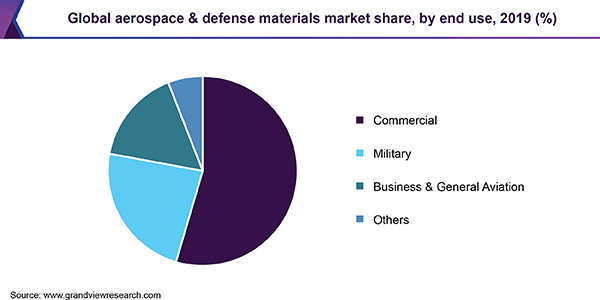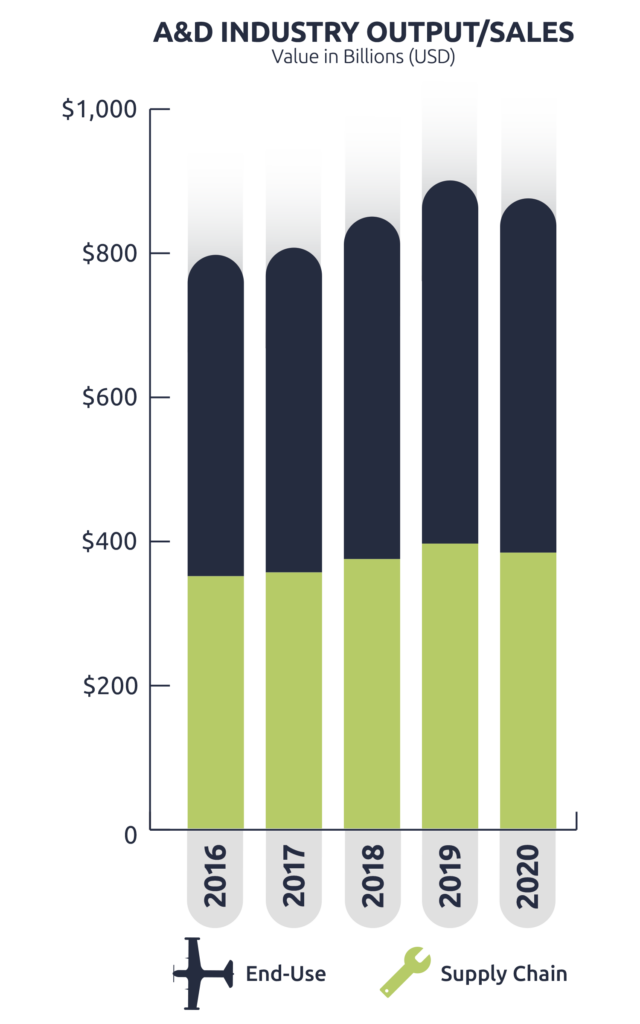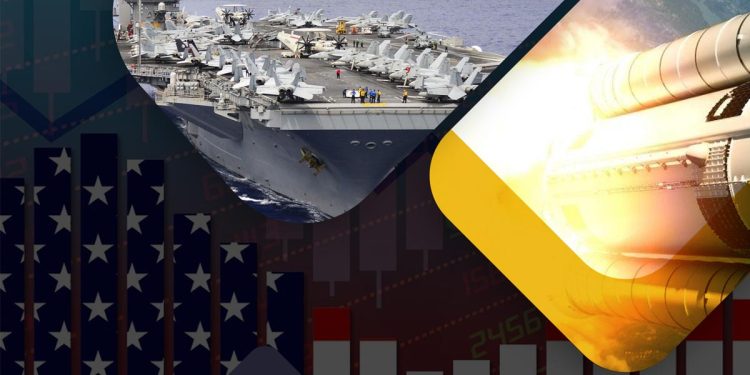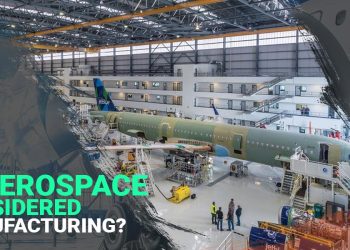As the economy smoothly moves to the second quarter of 2022, air travel seems to contribute better. Though the current rise in cases of COVID is making the situation uncertain, the travel industry will not be shut down this time.
However, the need for small and medium-sized aircraft still needs some time to recover and reach the pre-pandemic level. This has raised many eyebrows as economists contemplate the impact of aerospace and defense on the US economy.
Take a broader look into how aerospace and military are empowering the economic force of the US in this article.
Status of Aerospace & Defense in the US

Source: GrandViewResearch
There is no denying that the US military is one of the most potent forces in the world. Also, aerospace plays a significant role in maintaining the supply chain management and travel smoother.
Having advanced technology and superior military force, the impact of aerospace and military is sure to have a significant effect on the US economy. Also, multiple achievements in this domain have allowed the US to lead the industry with pride.
The aerospace and defense industry also happens to be the largest employer in the country. Hence, the economic baseline is defined by these industries in the country. The United States has become a hub of the supply chain, defense contracts, and fulfilling manufacturing requests. So, to meet these requirements successfully, aerospace will have to evolve itself.
The following section will explain the impact of aerospace and defense on the US economy. To understand this at a deeper level, there is a list of some expected trends and changes in the sector.
Current Trends Defining the Impact of Aerospace and Defense
The US economy is driven by the impact of the aerospace and defense industry’s innovation and evolving business models. With an increase in the demand for manufacturing and supply chain, the shift will be towards adopting digital and intelligent techniques.
Undoubtedly, adopting these efficient and productive technologies can quickly intensify the impact of aerospace and defense. Below are some current trends that add to their impact on the US economy.
Intelligent Factory Setups with Digitalization
Digitalization is trending in every industry because of its ability to make the business agile during uncertain times. Reports suggest that intelligent factory setups will increase product manufacturing capacity, reduce the cost, and keep the setup flexible.
Furthermore, this will contribute to the supply chain by leveraging product visibility and streamlining the system.
Technological Advancement in Military Manufacturing
Defense spending has remained stable and increased gradually because of its isolation from commercial space. The impact of aerospace and defense are not the same on the economy because they operate differently.
The latter doesn’t depend on the external source for leveraging the economy because the need for fighter aircraft, shipbuilding, and cybersecurity hasn’t gone down during the pandemic.
Currently, the military manufacturing units are headed towards technological advancement. Subsequently, this is the green signal that the number of contracts is rising from fellow countries.
Similarly, the aerospace industry is laying the foundation for next-gen satellites. Therefore, space-based services will enhance the experience for customers, businesses, and society in many ways.
Decarbonization
The fuel industry is proactively working towards decarbonization. So, the aerospace and defense sectors also have some responsibilities. By incorporating advanced technologies, the industry is enhancing its fuel efficiency.
Hence, the impact of aerospace and defense will be massive if they manage to cut down the emissions and find greener ways to operate.
Financial Discipline
The lockdown phase of the pandemic has taught the world enough about financial discipline and managing stability in the accounts department. Hence, the reports suggest that companies with better spending structures will rule the industry.
Also, this ensures that the impact of aerospace and defense on the economy becomes significant because the key players in the industry are looking forward to reevaluating their investments, portfolios, and balance sheets.
Now, it is easier to understand how the current scenario will shape the impact of aerospace and defense on the economy. You can also explore some technological trends in the industry and analyze their economic impact.
Analysis of Economic Impact
The impact of aerospace and defense on the economy of the US is based on multiple pillars. All these pillars contribute to the economy in their ways. Hence, there is also plenty of scope for improvement with such diversification.
Below is a list of factors that collectively build the impact of aerospace and defense on the country’s economic domain.
-
Employment
Statistical analysis suggests that employment has a ripple effect on the aerospace and defense industry because, for every 10 jobs created in core areas, there are 20 vacancies created in the supply chain.
This reflects that the industry is responsible for 2% of the nation’s total employment base. The US military’s manufacturing facility is vast and has created bulk job opportunities since the pandemic has slowed down.
For example, there is a hierarchy of job opportunities in the defense sector alone. Below is a brief explanation for the same.
- For building the aircrafts manufacturing units, there is a need for manufacturing the parts of aircrafts
- To kickstart the production of armored vehicles, there is a need for a separate facility to manufacture arms
- Fulfillment of tank requirements is possible with the manufacturing of tank components
-
Sales
The impact of aerospace and defense is broadly measured by the final sales of all things manufactured. The purchase of intermediate goods and services and value-added goods and services significantly contributes to the economy.
These sales take place at both local and national and international levels. The sum of value-added and intermediate purchases is enormous and is expanding at 1.3% annually.
After including both direct and indirect sales of the industry, the value was $178 billion in total. Furthermore, employees working in this sector spend their wages on financial, IT, professional, and manufacturing services.
-
Export
Calculating the overall impact of aerospace and defense on the economy, the export accounts for more than sales. Nearly $151 billion worth of goods were exported to different countries from the US, making the A&D industry the largest exporter in 2018.
-
Supply chain
The impact of aerospace and defense is significant because of the broad network of the supply chain industry. Furthermore, the supply chain is not just confined to local and national locations but also to other countries of the world. The supply chain accounts for nearly 49% of the total revenue summing up to $400 billion.
-
Taxes
Firms associated with manufacturing aerospace and defense equipment pay taxes at both federal and state levels. These companies make a significant contribution of up to $50 billion, accounting for 1.6% of the total federal budget. Hence, the impact of aerospace and defense is significant in terms of tax payment.
Interestingly, the decline in revenue of the aerospace and defense industry from 2019 to 2020 is only by a small margin of $40 to $50 billion. However, these numbers only represent the revenue of end-use manufacturers and the supply chain industry.
The core area of defense has remained strong throughout. Besides, the most surprising fact is that the impact of aerospace and defense in 2020 is better than that in 2016, 2017, and 2018.

Source: AIA Aerospace
It is benefitting the sectors starting from retail to leisure and hospitality. Also, the industry is creating jobs, making way for innovation, and adopting greener alternatives for current processes.
Furthermore, the economic impact of aerospace and defense has been positive because of a consistent inflow of taxes for state and local governments.
FAQs
1. How are defense and aerospace trying to work on sustainability?
Ans: The industry is trying to adopt sustainable aviation fuel that comes from non-conventional sources like plant oils and municipal waste. These fuels reduce carbon emissions by 80% and have lesser impurities.
2. Is the cargo market larger than the passenger market?
Ans: Yes, current numbers suggest that the cargo market is larger than the passenger market. However, the next decade will see expansion in both the markets and the market size will be equivalent.
3. What are some top export destinations for the US aerospace and defense industry?
Ans: The top destinations are Germany, the UK, France, China, Japan, Canada, and Brazil.
4. Which aerospace subsector has the maximum contribution to exports?
Ans: Civil aerospace has a maximum contribution in exports, followed by defense aerospace and defense non-aerospace.
Summing Up
Without a doubt, aerospace and defense are vital components of the US economy, and the manufacturing facility of the US military has been immune to the declining effects of the pandemic.
Furthermore, the continuation in the operation of this industry has managed to open the doors for innovation in aerospace and defense.
This has further empowered medium-sized industries like the metal industry, IT domain, and design industry to stay proactive. Hence, the economic impact of aerospace and defense in the US has a broad ripple effect in multiple domains and will continue to do so in the coming times.
Read Also:
Gracie Johnson is a Senior Content Writer at MyTechMag. She is an enthusiastic learner and loves to explore all the areas of technology.







